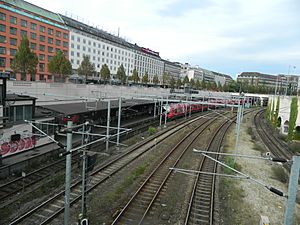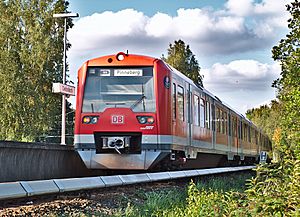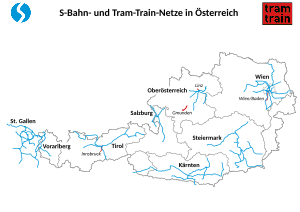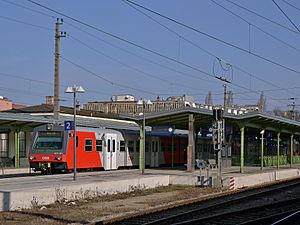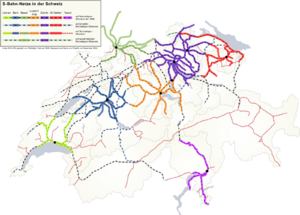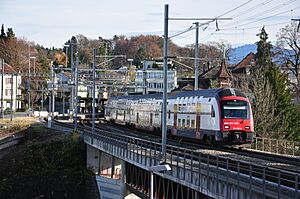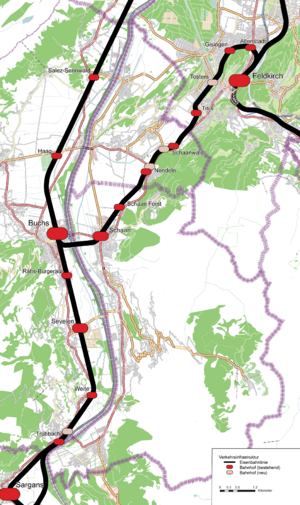S-Bahn facts for kids
The S-Bahn is a special type of train system. It connects cities with their nearby suburbs. You'll find S-Bahn systems mostly in countries where German is spoken.
Some S-Bahn systems are like a metro or subway, moving lots of people quickly in big cities. Others are more like commuter trains, connecting smaller towns. The name S-Bahn comes from German words like Schnellbahn (meaning "rapid train") or Stadtbahn (meaning "city train").
Similar train systems exist in other countries too. In Austria and Switzerland, they are also called S-Bahn. Belgium has the S-Trein or Train S. In Denmark, they are known as S-tog, and in the Czech Republic as Esko or S-lines.
Contents
What Makes an S-Bahn Special?
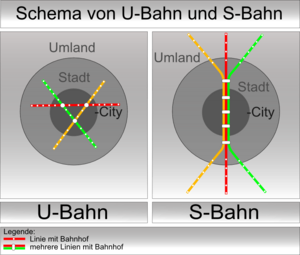
There's no single rule for what an S-Bahn is. But generally, S-Bahn trains are the most local passenger trains. They stop at all stations on the main railway lines in and around a city. Other long-distance trains usually only stop at major stations.
S-Bahn trains are often slower than other regional trains. However, they are great for getting across a city quickly. For example, the Copenhagen S-tog can go up to 120 kilometers per hour (75 mph). This is faster than most city heavy rail systems. S-Bahn trains usually serve the area around one city. They don't typically connect different cities. But in very crowded areas, like the Rhine-Ruhr S-Bahn, they do connect many cities and towns.
Most S-Bahn systems use older railway tracks. Sometimes, they run on tracks built just for them, next to existing lines. S-Bahn trains get their power from overhead lines or a third rail. In Hamburg, some lines use overhead lines, and others use a third rail.
In smaller S-Bahn systems, trains often share tracks with other types of trains. But in big cities like Berlin, Hamburg, and Copenhagen, S-Bahn trains often have their own tracks. Busy S-Bahn routes might have special sections of track just for them. Many large S-Bahn systems have main lines in the city center. These lines are often underground, like a metro. Many suburban lines feed into these central tunnels, making them very busy. The Berliner Stadtbahn in Berlin is a good example. It's even a popular tourist spot!
Further away from the city center, S-Bahn lines branch out. The distance between stations can be more than 5 kilometers (3 miles). This allows the S-Bahn to do two jobs: local transport within the city and connecting the city to its suburbs. How often trains run changes a lot. In busy city parts, trains come very often. In faraway areas or late at night, they might come every 20 minutes or more.
The trains used for S-Bahn systems are designed for both short and longer trips. They have space for people to stand, but also comfortable seats.
S-Bahn systems usually work well with other local transport. This means you can easily switch between S-Bahn lines, metros, or buses. Tickets are often valid for all these different types of transport. For example, in cities with both S-Bahn and metro, you can often use the same ticket for both. The S-Bahn Mitteldeutschland is the main local train system for Leipzig. It also connects to Halle, which is another city. The Rostock S-Bahn is an example of a smaller S-Bahn system.
Where the Name Comes From
Germany, Austria, and Switzerland
The name S-Bahn is short for the German word Stadtschnellbahn. This means "city rapid railway." It was first used in Berlin in December 1930. This was when they were rebuilding the suburban train tracks. The first electric section opened in 1924, which led to the creation of the Berlin S-Bahn.
The main Berlin city railway became electric in 1928. The circular line, Berliner Ringbahn, became electric in 1929. More suburban lines were electrified too. Trains started running very often, sometimes every 2 minutes, especially during the 1936 Summer Olympics in Berlin.
Other cities also had similar ideas. Hamburg had an electric railway since 1906. In 1934, it started using the S-Bahn name, just like Berlin. In the same year, Copenhagen's S-tog opened its first line. In Austria, Vienna's city railway became electric in 1908. It started using the term Schnellbahn ("rapid railway") in 1954 for its new commuter network. It officially became S-Bahn Wien in 2005.
In Munich, plans for an S-Bahn-like system started in 1938. It was meant to run through tunnels in the city center. But these plans stopped during World War II. Munich's S-Bahn system, which is very big today, only started operating before the 1972 Summer Olympics.
Denmark
In Denmark, the "S" in S-tog stood for "station." Before the first line of the Copenhagen S-train network opened, a newspaper held a competition to name it. But since an "S" was already put up at all the stations, the name became S-tog, meaning "S-train." This happened a few years after S-trains opened in Berlin and Hamburg. Today, the Copenhagen S-trains have six lines and serve 86 stations. Many of these are within the city. Trains usually run every 10 minutes on most lines. In busy areas where lines meet, there can be up to 30 trains per hour!
A Look Back in Time
Germany
Early Steam Trains
In 1882, more and more steam trains were running around Berlin. So, the Prussian State Railway built separate tracks for suburban trains. The Berliner Stadtbahn connected Berlin's main train stations. A cheaper ticket price was introduced in 1891 for the new Berliner Stadt-, Ring- und Vorortbahn (Berlin City, Circular and Suburban Rail). This made short-distance travel very popular.
Hamburg also had a suburban railway connecting Hamburg with Altona. This railway became electric in 1906.
The Switch to Electricity
In the early 1900s, the first electric trains appeared. In Germany, many used 15,000 volts from overhead lines. But the Berliner Stadt-, Ring- und Vorortbahn used direct current (DC) trains running on 750 volts from a third rail. The first electric route opened in 1924. The third rail was chosen because it was easier to change the tracks and allow both electric and steam trains to run side-by-side.
To tell it apart from the underground U-Bahn (subway), the name S-Bahn was used from 1930.
Hamburg's electric service started in 1907. In 1940, a new system with a 1200 V DC third rail was added. The old system with overhead wires was used until 1955. In 1934, the Hamburg-Altonaer Stadt- und Vorortbahn was officially renamed S-Bahn.
Similar Train Systems Around the World
Austria
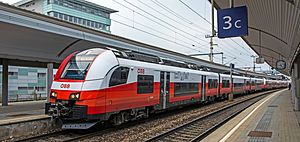
The oldest and largest S-Bahn system in Austria is the Vienna S-Bahn. It started in 1962. It was called Schnellbahn until 2005. Its logo is a white "S" on a blue circle.
In 2004, the Salzburg S-Bahn opened. It's special because it crosses the border into Germany! It connects Salzburg with towns in Bavaria. Different companies operate parts of this network.
Other S-Bahn systems in Austria include:
- The S-Bahn Vorarlberg (2006) in the Rhine Valley.
- The S-Bahn Steiermark (2007) connecting Graz with its surrounding area.
- The Tyrol S-Bahn (2007) around Innsbruck.
- The S-Bahn Kärnten (2010) in Carinthia.
- The S-Bahn Oberösterreich (2016) in the Linz area.
Belgium
The suburban trains in Brussels are becoming part of the Brussels Regional Express Network. This system uses the letter S. In 2018, S-trains were also started in other Belgian cities like Antwerp and Ghent.
Czech Republic
In the Czech Republic, commuter train systems in Prague and the Moravian-Silesian Region are called Esko. This is how the letter "S" sounds in Czech. Esko Prague started in 2007, and Esko Moravian-Silesian Region in 2008.
Denmark
The Copenhagen S-train connects the city center with its suburbs. The average distance between stations is 2.0 kilometers (1.2 miles). Some stations are about 40 kilometers (25 miles) from the city center. So, ticket prices depend on how far you travel. On weekdays, trains usually run every 10 minutes. In busy areas, trains can come every few minutes.
The Copenhagen Metro opened in 2002. It works together with the S-train system. Copenhagen's S-train system is the only one in Denmark.
Germany
The S-Bahn systems in Berlin and Hamburg have always had their own tracks. But when other German cities started S-Bahn systems in the 1960s, they mostly used existing train tracks.
Major cities like Frankfurt, Leipzig, Munich, and Stuttgart have main train stations where all lines end. So, their S-Bahn networks often use tunnels under the city center.
The Ruhr area has many large cities close together. So, the S-Bahn Rhein-Ruhr connects all these cities and suburbs. It has fewer tunnels and longer routes than other networks. It's also the only S-Bahn network in Germany run by more than one company.
Most German S-Bahn networks have their own ticket systems. These tickets are often valid for local buses and subways too.
One S-Bahn system, the Erfurt S-Bahn, operated from 1976 to 1995. It was a short, single-line system.
New S-Bahn systems are being planned in cities like Augsburg and Lübeck.
Here are some of the S-Bahn networks currently running in Germany:
| S-Bahn | Area Served | Opened | Lines |
|---|---|---|---|
| Berlin S-Bahn | Berlin, Potsdam | 1924 | 16 |
| Breisgau S-Bahn | Freiburg im Breisgau | 1997 | 7 |
| Bremen S-Bahn | Bremen, Bremerhaven, Oldenburg | 2010 | 4 |
| Dresden S-Bahn | Dresden | 1992 | 3 |
| Hamburg S-Bahn | Hamburg | 1934 | 6 |
| Hannover S-Bahn | Hannover, Paderborn, Hildesheim, Minden | 2000 | 9 (+ 1) |
| Mitteldeutschland S-Bahn | Leipzig, Halle (Saale), Zwickau, Bitterfeld | 2013 | 10 |
| Mittelelbe S-Bahn | Magdeburg | 1974 | 1 |
| Munich S-Bahn | Munich | 1972 | 8 |
| Nürnberg S-Bahn | Nürnberg, Ansbach, Bamberg, Erlangen | 1987 | 6 |
| Rhine-Main S-Bahn | Frankfurt am Main, Wiesbaden, Mainz, Darmstadt | 1978 | 9 |
| RheinNeckar S-Bahn | Mannheim, Karlsruhe, Ludwigshafen am Rhein, Heidelberg | 2003 | 7 |
| Rhein-Ruhr S-Bahn S-Bahn Köln |
Ruhrgebiet (esp. Duisburg, Essen, Bochum) Rheinland (Köln, Düsseldorf, Wuppertal) |
1967 1975 |
14 |
| Rostock S-Bahn | Rostock | 1974 | 3 |
| Stuttgart S-Bahn | Stuttgart, Waiblingen, Esslingen | 1978 | 7 |
Switzerland and Liechtenstein
The term S-Bahn is also used in the German-speaking part of Switzerland. In French-speaking areas, they might call it RER. But the line numbers still start with an "S". In Italian-speaking parts, they call these networks rete celere (fast network).
The oldest S-Bahn network in Switzerland is the Bern S-Bahn, which started in stages from 1974. The Zürich S-Bahn opened in 1990. It's a very large network with many services. Other S-Bahn services were set up in Central Switzerland and Eastern Switzerland.
The Basel trinational S-Bahn serves the Basel area. It even goes across borders into France and Germany!
An international S-Bahn network also exists between Switzerland and Italy. It connects the Swiss Canton of Ticino with the Italian state of Lombardy.
The RER Vaud in Lausanne and the Léman Express in Geneva serve the area around Lake Geneva. The Léman Express is Europe's largest cross-country S-Bahn network, going into France.
There are discussions about a new international S-Bahn network around Lake Constance. This would connect parts of Germany, Austria, Liechtenstein, and Switzerland.
Swiss S-Bahn services are run by the Swiss Federal Railways (SBB CFF FFS) and also by private railway companies. Swiss trains are known for being very well-coordinated. S-Bahn services are used by people going to work or school, and also by tourists visiting attractions.
See also
 In Spanish: S-Bahn para niños
In Spanish: S-Bahn para niños
- Commuter rail
- U-Bahn
- Urban rail transit


